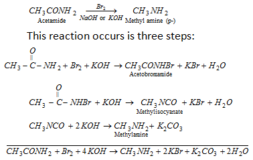Acetaldehyde

source : science madness.wiki-wikia
1) Oxidation –
Aldehydes are easily oxidised & thus act as reducing agents . Aldehyde on oxidation form corresponding acid containing same number of carbon atoms.
RCHO +[O]—–> RCOOH {acid}
CH3CHO + [O] —–> CH3COOH [acetic acid]
Oxidising agents may be strong such as acidified K2Cr2O7 or acidified KMnO4 or mild such as Tollen’s reagent or Fehling solution or Benedict solution.
Tollen’s Reagent-
It is an ammonical solution of Silver nitrate. When aldehyde is added to tollen’s reagent, Ag2O is reduced to silver which deposits as black ppt. or silver mirror.
RCHO + Ag2O—-> RCOOH + 2Ag (silver mirror)
CH3CHO + Ag2O—-> CH3COOH + 2Ag (silver mirror)
Fehling solution-
It is an alkaline solution of cupric ion complexed with sodium potassium tartarate . Aldehyde reduces cupric ion (blue ) to cuprous oxide (red).
Fehling solution I – dilute solution of CuSO4
Fehling solution II – Sodium potassium tartarate & NaOH
RCHO + 2 CuO —–> RCOOH + Cu2O(red ppt. of cuprous oxide)
Benedict’s solution- It is a solution of CuSO4, Sodium citrate & Na2CO3. When heated with an aldehyde , a reddish brown ppt. appears.
2) Reaction of Acetaldehyde with alkali –
Aldehydes having alpha hydrogen atom on heating with alkali (Except Formaldehyde) give a brown resin like substance of characteristic odour.
CH3CH=O + H2CHCH=O +H2CHCH=O —–> CH3CH=CHCH=CHCH——— (Brown resin)
3) Tischenko’s Reaction-
This is a modified form of Cannizarro’s reaction . All aldehydes undergo Cannizarro’s reaction in Aluminium ethoxide. The acid & alcohol formed react together to give an ester.
2CH3CHO —–> [CH3COOH + C2H5OH] ——> CH3COOC2H5 (ester)
4) Reaction with alcohols-
Aldehydes combine with alcohol in presence of dry HCl gas forming hemiacetal then acetal.
CH3CH=O + HOC2H5——> CH3CH(OH)OC2H5 [hemiacetal] —-> CH3CH(OC2H5)2[acetal]
Uses :
1. As an antiseptic.
2. In the preparation of paraldehyde and metaldehyde.

source : slide player.com







